 |
| Sears Belmont • circa 1916 • 501 W. Spencer Avenue, Marion, Indiana |
 |
| The Sears Belmont in the 1918 Sears Modern Homes Catalog |
We've known for a while that an old bungalow-style Sears Belmont was built somewhere in Marion, Indiana, but we didn't know where. We knew, because, in the catalogs from about 1917-1920, on the page of the catalog showing the Belmont, there was a short list of places where Sears knew that a Belmont had been built. These little blurbs always start with, "Built at...." and then continue to list a few towns where the model was built. Well, the Belmont was listed as having been built at Marion, Indiana; Antioch, Illinois; and Armington, Illinois. We had found the one in Antioch, Illinois, but not a Belmont in those other two locations. Well, yesterday, eagle-eye researcher, Karen DeJeet, noticed that a house posted on the Facebook page, For the Love Of Old Houses, looked to be an old-style Sears Belmont.
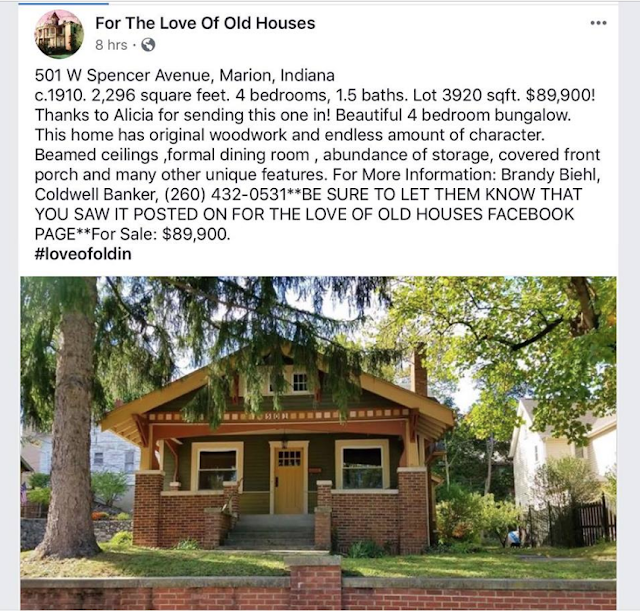 |
| Here's our Marion, Indiana Sears Belmont, as shown on the FB page, For the Love Of Old Houses |
When Karen checked further, she eventually learned that Marion was a "built at" location for the Sears Belmont (we call that an "advertised house"), so we have added it to our National Database of Sears Houses as an authenticated Sears house.
 |
| Here's the mention of Marion, Indiana, on the 1918 catalog page for the Belmont. |
Now, there were two models that Sears called the Belmont. This is the first, and older, of the two. It ran in the catalogs from about 1914 through 1921. We only have about 16 on our National Database of Sears Houses in the United States, so we were excited to see this one. These old models are hard to authenticate, too, because they were not pre-cut, and many would have been sold pre-1916, which means that they wouldn't have been labeled on any wood pieces. In fact, researcher Andrew Mutch has found two in New York that he thinks have Sears mortgages tied to them, but they have a few differences in their look, so he has not added them to our list.
In 1931 or 1932, Sears offered a brick-veneer version of their popular LynnHaven design, and called it the Belmont. You can read about an authenticated one, that's in another town in Indiana (Hammond), at this blog post of mine.
 |
| An authenticated early 1930s Sears Belmont, in Hammond, Indiana |
 |
| The Sears Belmont, in my late 1931 catalog. |
But, let's get back to our early Belmont, and take a look at a few of the years that it was offered in the catalogs. Notice how much higher the price is in the 1920 catalog, as the post-WWI era affected the price of wood, and that was reflected in the price of our Sears kits.
 |
| The 1914 catalog offered this model as the No. 237 (well, okay, as No. 264P237). |
 |
| Here is the Belmont in the 1918 catalog... four years later, and approaching twice as expensive as the 1914 kit. |
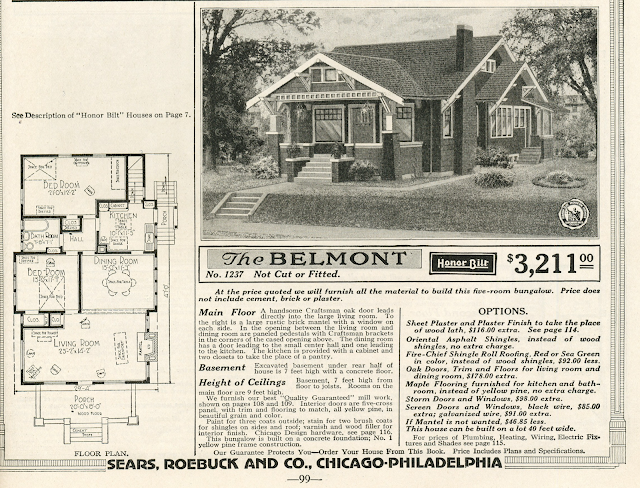 |
| This is the catalog listing for the Sears Belmont bungalow, from 1920. The price had almost tripled from the 1914 price. |
One thing that is rather unique about the Belmont, is the long stretch of windows on the right side elevation. In the bump-out area, we see a run of four slim windows, right next to each other, followed by a shorter pair of slim windows, right next to each other, and then a side door... all of that under the eaves of that peaked-gable bump out. The side door has its own little straight-line, flat roof overhang. If we think a house might be a Belmont, we look for this window-door configuration on the right side. Our Marion, Indiana house, has it.
 |
| Right side elevation of the Sears Belmont in Marion, Indiana |
Another thing we look for on the Belmont, is the use of the Sears five-piece bracket. We want to see them placed just as the catalog image shows... and, they are, on our Marion, Indiana Belmont. We also hope to see the unique design along the lintel, that long rectangular stretch of area at the base of the front gable. That is present, too, on the Marion, Indiana house.
 |
| Design elements of the early Sears Belmont. |
 |
| Wonderful original elements: five-piece brackets, and the series of little squares that run along the base of the front gable. |
Interior Elements Of the Sears Belmont
We are so fortunate to have interior views of this house, and doubly fortunate that it has been beautifully cared for over its 100+ years. The interior is simply stunning. Additionally, we are able to see a few millwork elements that match what was offered in the 1915 Sears Building Materials catalog, and that is always exciting. Let's take a look (note that the photos of the house all come from the MLS listing photos, available here, on Realtor.com).
 |
| First floor plan of the Sears Belmont bungalow, 1918, that has a sleeping porch next to the back bedroom. |
July 2022 Edit:
Shari D. commented to point out that there is a slight difference between the floor plan shown for this model in 1918 and 1920. The difference is in the back of the house. The earlier floor plan has a sleeping porch next to the back bedroom. In 1920, that sleeping porch has been absorbed into the back bedroom, causing, as well, a little change to the hallway access to that room:
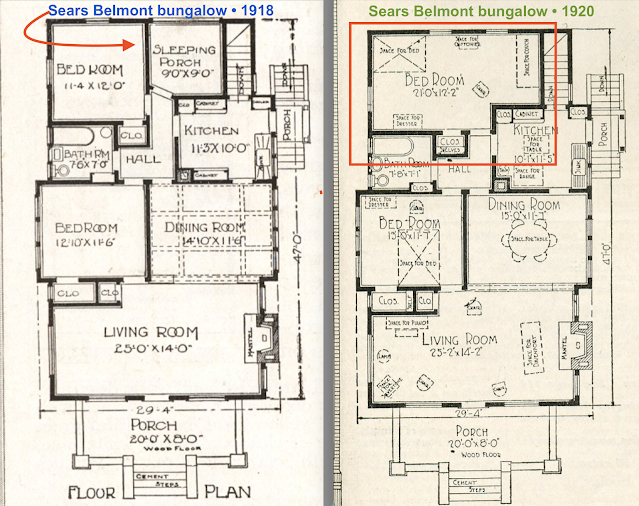 |
| Sears Belmont bungalow, 2 floor plans showing a difference in the back of the house. Thanks to Shari D. for pointing this out! |
The floor plan offers a nice, spacious, long living room, and lots of windows along both sides of the house. Here are views of three areas of the living room:
 |
| The beautiful right side of the living room, looking into the dining room. Those look certainly to be original wood floors. |
 |
| A center view of the stretch of living room, focusing on that beautiful, original Craftsman M Sears door. |
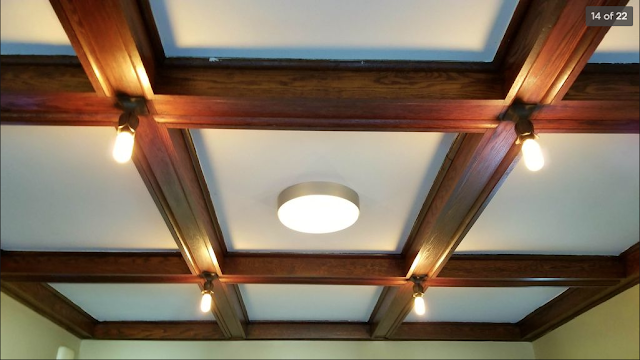 |
| The beams are only decorative, but they sure add a nice touch. |
Here is the front porch and entry area of the house. I'm showing this now, to show the exterior side of that Craftsman entry door. I found that offered in the 1915 Sears Building Materials catalog, and I should add that it's a style that we don't see very often in later years, with that lovely stretch of three long, slim rectangular inset areas. That nicely mimics the many long, slim windows along the sides of the house, and, in this house, the interior doors are of the same style, though with a solid upper section.
 |
| Beautiful Sears Craftsman-M door. |
 |
| Here is that Craftsman-M door offered in the 1915 Sears Building Materials catalog. |
As you move from the living room, into the dining room of the house, you immediately see, of course, the wonderful Craftsman style bookcases and colonnades, that separate the two rooms:
Lots of windows in that dining room, where the bumpout is, and you can see the nice back side of the book cases:
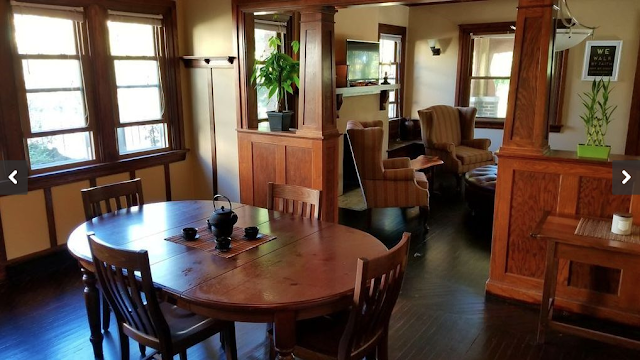 |
| Dining room, looking into the living room. The right side of the dining room is that bumped-out section of the right side of the house, with its stretch of four long windows. |
This room, off of the closet end of the living room, is being used as an office or reading room, I believe, though the Sears floor plan shows this as one of the first-floor bedrooms. You can see the door to the closet that I mentioned earlier... note that it is an interior version of that Craftsman front entry door with the three rectangular inset sections:
 |
| First-floor bedroom, off of the living room, being used as an office or reading room. |
 |
| Here is the Craftsman I door in the 1915 Sears Building Supplies catalog. |
Even the bathroom in this house, retains its original layout, with the two windows flanking the sink and medicine cabinet. I believe that is an original porcelain tub, as well. Those were nice and deep in the era when this house was made... nothing like the little shallow things you see today in houses from the past forty or fifty years.
 |
| This is a pretty spacious bathroom for an older bungalow, I think. |
Let's finish up with a few more photos of the exterior of this great house:
EDIT: Thanks to research by Alan Miller, of Marion, Indiana, we now know that the first residents must have been Earl J. Mason, and his wife, Grace. He found them at this address in the 1916 city directory, and here they are, listed in the 1919 city directory that I was able to see on Ancestry.com:
Mr. Mason's 1940 obituary mentioned that he was the Secretary-Treasurer of the Canton Glass Company. The 1940 U. S. census shows that Earl and Grace had two sons, Richard, and Earl J. Jr.
A Few Other Sears Houses In Marion
Other researchers in our group have found these additional Sears houses in Marion:
Sears Hamilton bungalow: 2224 S Boots Street, Marion, Indiana
 |
| Sears Hamilton bungalow in the 1929 Sears Modern Homes catalogue, here . |
Sears Woodland: 2120 S Boots Street, Marion, Indiana
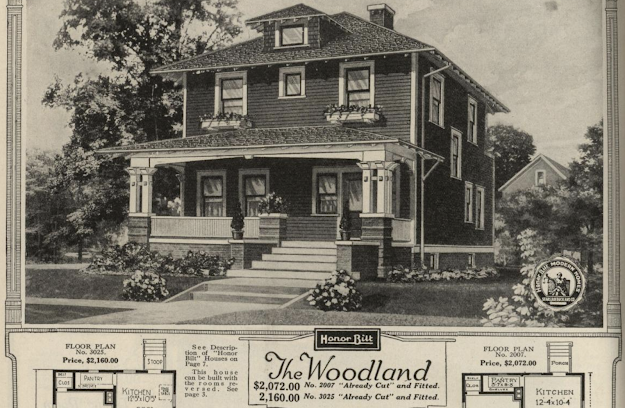 |
| Sears Woodland • 1921 Sears Modern Homes catalogue, here |
 |
| The house in Marion has the floor plan indicated by the red square, above. |
Though it needed some loving care to restore it, the real estate listing of this Woodland on S. Boots Street shows it to be full of original Craftsman woodwork.
Sears Willard at 1142 W 6th Street, Marion, Indiana
 |
| You can see the interior of this Sears Willard, at this link for a real estate listing |
 |
| Sears Willard • 1932 Sears Modern Homes Catalog, here |
•••••••••••••••••••••••••••••••••••••••••••••••••••••••••
For more information on who we are, and what we do, visit our website: SearsHouses.com








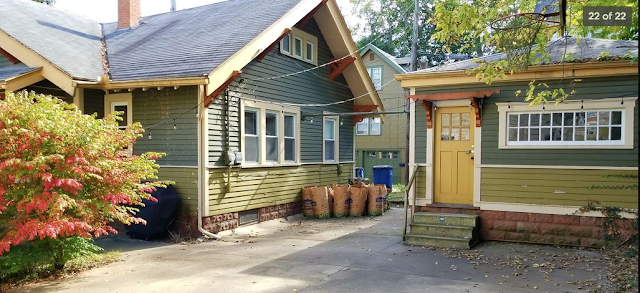
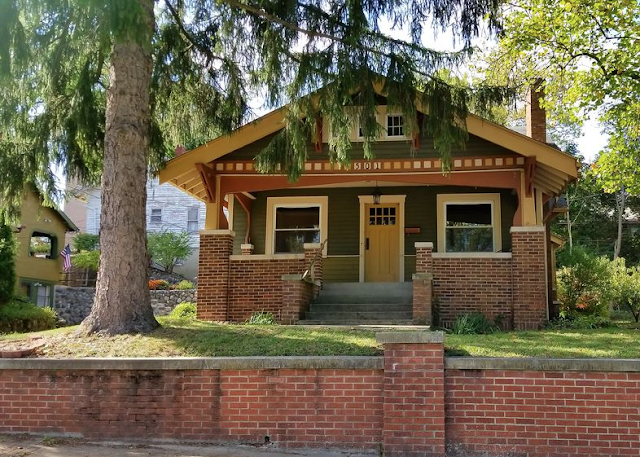





What a perfect Belmont! It's beautiful!
ReplyDeleteI drive by this house every day but had no idea it was a Sears house. Thank you for this wonderufl article!
ReplyDeleteYou're welcome! I'm glad that Karen spotted it as the Marion, Indiana, Belmont!
DeleteWhat a lovely home, and very interesting to read about the history.
ReplyDeleteThis was very interesting. I grew up in the Antioch, IL Belmont house.
ReplyDeleteSome things I noticed:
ReplyDeleteFirst, as usual, a very detailed and informative post about a rather unique bungalow plan!
The whole time it was the bungalow plan, from 1914 to 1920, it never was "cut to fit"! It was always a "do it yourself" proposition. With all the other kits that WERE "cut to fit," I wonder why this one wasn't?
Also, the plan with the front elevation shown for 1920, for over $3200, the floor plan is not the same as the individual floor plan you showed a little further down as the 1920 floor plan? Were there two different plans?
That back bedroom shown in the first 1920 whole house elevation, plus the floor plan and the description, was enormous, almost all the way across the back of the house, only meeting up at the back stairs from the kitchen, and kind of like the living room spans the front. The other floor plan shows a much smaller, boxier bedroom, with a portion of the other larger bedroom given over to a sleeping porch.
The photograph of the bathroom inside the house is quite large for a bungalow plan, but not the same bathroom layout as shown in the catalog image. I looked at the 1920 layout a little closer, and was kind of curious if you think it's the same size room, but with the tub and toilet rearranged? I noticed that the sink is in the original spot between the two windows, but the tub and toilet were not in the original positions. Or, is this the same layout in the older plans? I haven't looked for the older catalogs you show here yet on archive.org, so its a bit challenging to figure them out!
Ok - I'm done "nitpicking" details for now!!😉
Shari Davenport.
Oh, hey, thanks for pointing that out, Shari! I've made some updates to show the change in the floor plan!
Delete